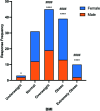Multicenter questionnaire study investigating characteristics of adults with unexplained chronic cough versus explained chronic cough
- PMID: 40958184
- PMCID: PMC12419969
- DOI: 10.2500/aap.2025.46.250065
Multicenter questionnaire study investigating characteristics of adults with unexplained chronic cough versus explained chronic cough
Abstract
Objective: Previously, we reported that older women taking increased numbers of cough medications with increased number and frequency of medical encounters and normal or near-normal lung function more likely had unexplained chronic cough (UCC) versus asthma and/or chronic obstructive pulmonary disease. This study sought to identify clinical risk factors that could differentiate UCC from explained chronic cough (ECC). Methods: A validated electronic questionnaire was distributed to patients with chronic cough (CC) at seven cough centers throughout the United States. The mean ± standard error, frequencies of continuous variables (one-way analysis), and cross-tabulation frequencies for categorical variables (two-way analysis) were calculated. Univariate comparisons between UCC and ECC were performed by using the t-test and nonparametric one-way analysis. Significant determinants of UCC and cough severity were assessed by using multiple logistic regression. Results: A total of 150 patients were enrolled, of whom 29 of 150 were classified as having UCC, and 121 of 150 were classified as having ECC. No significant differences for family history, age, gender, and race, or seasonality differentiated UCC from ECC. Multiple logistic regression revealed the absence of postnasal drip significantly differentiated UCC from ECC (odds ratio 4.8 [95% Confidence Level, 1.6-15.3]). The severity of CC was worse for patients with UCC, patients with chronic bronchitis and/or emphysema, hypertension, ex-smoking history, high body mass index, female gender, education level, and reactivity to more environmental irritants (perfume, p = 0.006; household cleaners, p = 0.01; air fresheners, p = 0.03; cold air, p = 0.007; cigarette smoke, p = 0.05). Conclusion: Patients with UCC more frequently presented with specific demographic features, comorbid characteristics, and more severe cough induced by environmental irritants compared with ECC. These clinical characteristics may be useful for identifying risk factors that can accelerate the diagnosis of UCC.
Conflict of interest statement
J.A. Poole is a site investigator for AstraZeneca, GlaxoSmithKline, and Regeneron Pharmaceuticals. A. White is a speaker for Blueprint, GSK, Genentech, Regeneron, Sanofi, AstraZeneca, Amgen; served on a GSK ad board; and received research support from Sanofi-Regeneron. J.A. Bernstein is a principal investigator and consultant for Merck and GSK. M. Sher is a consultant for Merck, Bellus, NeRRe, GSK, Nocion and Trevi, and had received honorariums from Merck and GSK. The remaining authors have no conflicts of interest to declare pertaining to this article
Figures


References
-
- Mazzone SB, Chung KF, McGarvey L. The heterogeneity of chronic cough: a case for endotypes of cough hypersensitivity. Lancet Respir Med. 2018; 6:636–646. - PubMed
-
- Irwin RS, French CL, Madison JM. Managing unexplained chronic cough in adults: what are the unmet needs? Lancet Respir Med. 2020; 8:745–747. - PubMed
Publication types
MeSH terms
LinkOut - more resources
Full Text Sources
Medical

